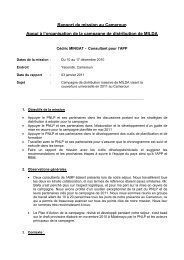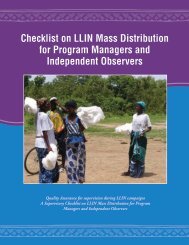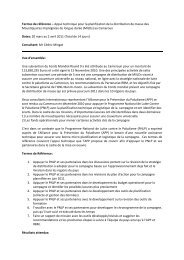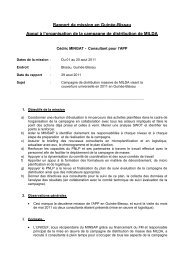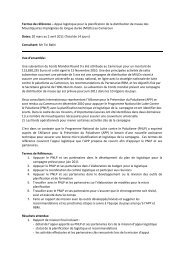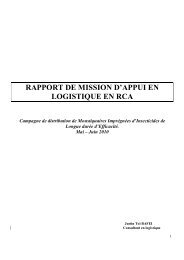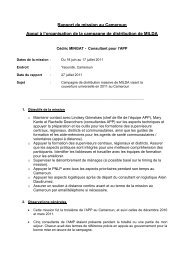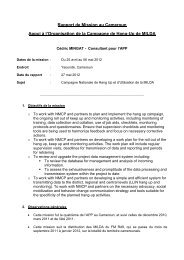Spots - Roll Back Malaria
Spots - Roll Back Malaria
Spots - Roll Back Malaria
- No tags were found...
Create successful ePaper yourself
Turn your PDF publications into a flip-book with our unique Google optimized e-Paper software.
STEP 3: ADAPT OR DEVELOP EFFECTIVE SPOTSThere are no hard and fast rules for using music in spot production. However, it isbest to use instrumental music (without words) when people are speaking becausevocal performances tend to compete for the listener’s attention. But occasionally awell-timed vocal piece with relevant lyrics can be just the right unexpected elementthat grabs the listener’s attention. Also, be aware of the dynamic range (the distancebetween the softest sounds and the loudest sounds in a piece) of the music becauseit can “disappear” during quieter parts.How do you know the music is right? Test it with your target audience to make sureit communicates the right mood and does not undercut the message. (Pretesting iscovered in Step 4.)Music use rights and permissionsBe aware of copyright laws regarding the use of music. Check whether you must paya royalty fee or secure permission to use the music you have chosen. Using a wellknownpiece of music can be expensive. Securing rights/permission to use music(“clearing”) often involves contacting two sets of people:• Publishers own the rights to words and music in written form. So, if you want toperform your own version of a song by Michael Jackson, you need permissionfrom the song’s publisher.• Record companies own the rights to the actual recorded performance.An alternative is to ask or commission someone to compose music for you or to get alocal band or musician to perform original material for your spot. Your studio mayalso have royalty-free music you can use or pre-produced music for use for a onetimefee.Sound effectsSound effects create an image in the listener’s mind in several ways:• Establish a place: Traffic sounds can create the image of an urban setting, whilethe sounds of chickens or cattle will evoke a rural one. People talking and babiescrying could sound like a clinic or hospital.• Create a mood: The sound of a woman humming while sweeping the floor cancreate a happy, homey image. The sound of running feet and banging doors cancreate a sense of urgency.• Establish time: The sound of roosters crowing tells the listener that it is earlymorning, while the chirping of crickets usually means it is evening. The ticking of aclock can communicate that time is passing.• Indicate entrances and exits: The sound of footsteps approaching (“fade-in”) orgoing away (“fade-out”) will help the listener understand that someone is enteringor leaving a room. The use of other sounds can reinforce those transitions. Forexample, if an actor leaves the scene angrily or hastily, he might slam a doorbehind him. Think of the different “images” you can create by speeding up or44 Spot On <strong>Malaria</strong>: Guide




